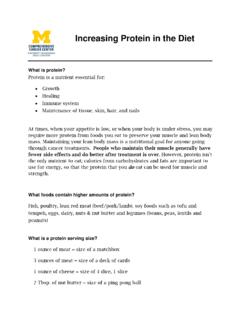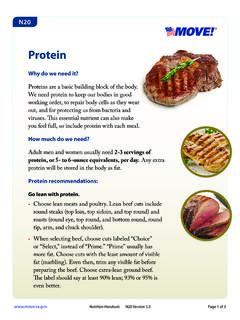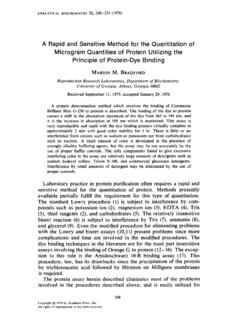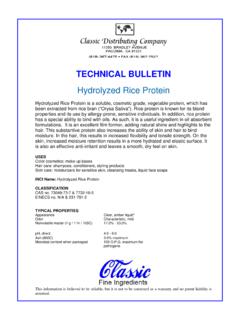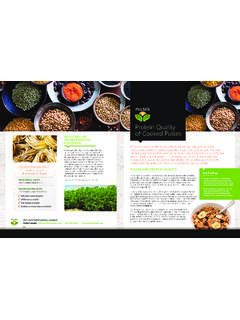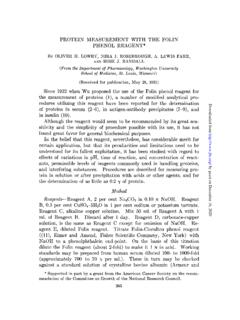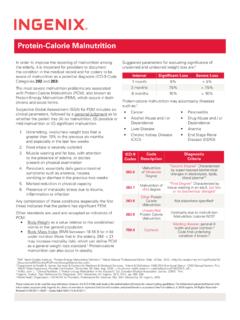Transcription of Edible Insects - Future prospects for food and feed security
1 67. 6. Nutritional value of Insects for human consumption Nutritional composition The nutritional values of Edible Insects are highly variable, not least because of the wide variety of species. Even within the same group of Edible insect species, values may differ depending on the metamorphic stage of the insect (in particular, for species with a complete metamorphosis known as holometabolous species such as ants, bees and beetles), and their habitat and diet. Like most foods, preparation and processing methods ( drying, boiling or frying) applied before consumption will also influence nutritional composition.
2 A few scattered studies analyse the nutritional value of Edible Insects ; however, these data are not always comparable due to the above-mentioned variations between Insects and because of the varying methodologies employed to analyse the compounds. Moreover, where commonly consumed, Insects comprise only a part of local diets. For example, in certain African communities Insects form 5 10 percent of the protein consumed (Ayieko and Oriaro, 2008). Nevertheless, because of their nutritional value they are still a highly significant food source for human populations.
3 Attempts are now being made to compile data on the nutritional value of Insects (Box ). This chapter looks at nutritional aspects of Insects for human consumption, while Chapter 8 touches on Insects in relation to animal nutrition. The main components of Insects are protein , fat and fibre; nutritional values are expressed in this chapter as dietary energy, proteins, fatty acids, fibres, dietary minerals and vitamins. Box The FAO/INFOODS food composition database for biodiversity The International Network of Food Data Systems (INFOODS), established in 1984, aims to stimulate and coordinate efforts to improve the quality and worldwide availability of food analysis data and to ensure that all people in different parts of the world can obtain adequate and reliable food composition data.
4 INFOODS and FAO are collecting data on food composition and consumption at many levels ( variety, cultivar and breed), and on wild and underused foods in order to promote biodiversity. The first version of the INFOODS Food Composition Database for Biodiversity, comprising analytical data from published and unpublished literature, was launched on 15 December 2010 and now includes the nutritional values of certain Edible Insects . To be included, nutritional values must be expressed as a 100 g Edible portion on a fresh weight basis (FAO, 2012f).
5 Rumpold and Schl ter (2013) compiled nutrient compositions for 236 Edible Insects , as published in the literature (based on dry matter). Although significant variation was found in the data, many Edible Insects provide satisfactory amounts of energy and protein , meet amino acid requirements for humans, are high in monounsaturated and/or polyunsaturated fatty acids, and are rich in micronutrients such as copper, iron, magnesium, manganese, phosphorous, selenium and zinc, as well as riboflavin, pantothenic acid, biotin and, in some cases, folic acid.
6 68 Edible Insects : Future prospects for food and feed security Dietary energy Ramos Elorduy et al. (1997) analysed 78 insect species from Oaxaca state, Mexico, and determined that caloric content was 293 762 kilocalories per 100 g of dry matter. For example, the gross energy (which is normally higher than metabolizable energy) of the migratory locust (Locusta migratoria) was in the range 598 816 kJ per 100 g fresh weight (recalculated from dry matter), depending on the insect's diet (Oonincx and van der Poel, 2011).
7 Table presents energy values expressed in kilocalories per 100 g fresh weight of selected wild and farmed Insects worldwide. Table Examples of energy content of differently processed insect species, by region Location Common name Scientific name Energy content (kcal/100 g fresh weight). Australia Australian plague locust, raw Chortoicetes terminifera 499. Australia Green (weaver) ant, raw Oecophylla smaragdina 1 272. Canada, Quebec Red-legged grasshopper, whole, raw Melanoplus femurrubrum 160. United States, Illinois Yellow mealworm, larva, raw Tenebrio molitor 206.
8 United States, Illinois Yellow mealworm, adult, raw Tenebrio molitor 138. Ivory Coast Termite, adult, dewinged, dried, flour Macrotermes subhyalinus 535. Mexico, Veracruz State Leaf-cutter ant, adult, raw Atta mexicana 404. Mexico, Hidalgo State Honey ant, adult, raw Myrmecocystus melliger 116. Thailand Field cricket, raw Gryllus bimaculatus 120. Thailand Giant water bug, raw Lethocerus indicus 165. Thailand Rice grasshopper, raw Oxya japonica 149. Thailand Grasshopper, raw Cyrtacanthacris tatarica 89. Thailand Domesticated silkworm, pupa, raw Bombyx mori 94.
9 The Netherlands Migratory locust, adult, raw Locusta migratoria 179. Source: FAO, 2012f. protein General information about proteins and various amino acids, as well as protein quality, are provided in Box Box Proteins and amino acids ( food chemistry ). Proteins are organic compounds consisting of amino acids. They are important elements of food nutrition but also contribute to its physical and sensory properties. The nutritive value depends on several factors: protein content, which varies widely among all foods;. protein quality, which depends on the kind of amino acids present (essential or non- essential) and whether the quality complies with human needs; and protein digestibility, which refers to the digestibility of the amino acids present in the food.
10 Amino acids are the building blocks required for the biosynthesis of all proteins through human metabolism to ensure proper growth, development and maintenance. Essential amino acids are indispensable because the body cannot synthesize them and so must obtain them through food. Eight amino acids are classified as essential: phenylalanine, valine, threonine, tryptophan, isoleucine, methionine, leucine and lysine. Nutritional values of Insects for human consumption 69. Xiaoming et al. (2010) evaluated the protein content of 100 species from a number of insect orders.










